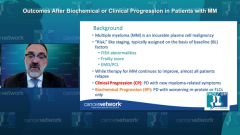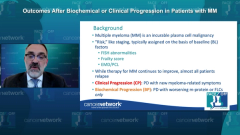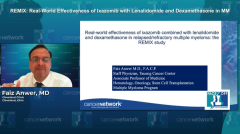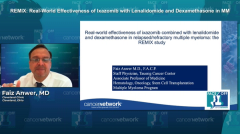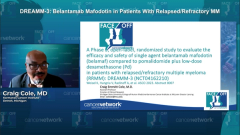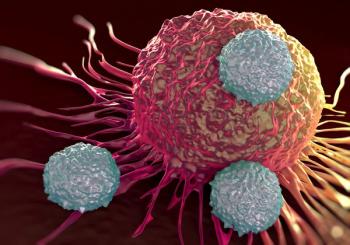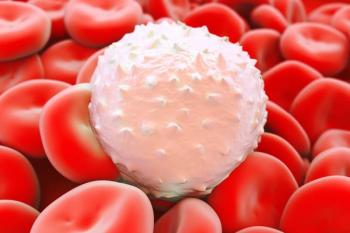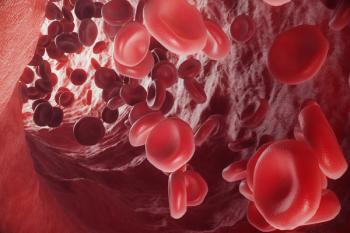
Outcomes After Biochemical or Clinical Progression in Patients with MM
Jeffrey A. Zonder, MD, reviews data on patient outcomes following biochemical or clinical progression in multiple myeloma.
Episodes in this series

Transcript:
Judy Schreiber, PhD, RN: We need to move on to the next presentation, which is going to be Dr Zonder talking about biochemical and clinical progression in patients.
Jeffrey Zonder, MD: I’m going to be presenting a review of a paper. This was not an abstract. This was a retrospective study conducted at the Mayo Clinic in Rochester, Minnesota, looking at biochemical vs clinical progressions in patients with multiple myeloma [MM].
MM is an incurable plasma cell [malignant tumor]. Risk, [such as] staging, is typically assigned based on baseline factors. The recent staging incorporates things [such as] specific FISH [fluorescence in situ hybridization] abnormalities. But we know that frailty scores affect patient outcomes as well, with older patients [with more frailty having poorer outcomes], and patients who present with aggressive disease characteristics [such as] EMD [extramedullary disease] or plasma cell leukemia [PCL], on the whole, clinically [have] worse [outcomes. Although] therapy, as we’ve seen in the past discussion, continues to improve, all patients essentially [experience] relapse.
In this paper, we’re going to compare the characteristics of patients who have clinical progression [CP], which is a progressive disease with the appearance of new CRAB [carbapenem-resistant Acinetobacter baumannii]-like symptoms, [with those who have] biochemical progression [BP], which means worsening of the M [monoclonal] protein or free light chains without the appearance of these CRAB symptoms.
The study’s primary objectives included comparing the prevalence and outcomes of patients with CP vs BP in a real-world setting to characterize the occurrence of different CRAB symptoms not just at diagnosis but also at relapse in the patients with CP and to explore the relationship between baseline symptoms and subsequent symptoms. There was also a secondary objective to look at baseline characteristics of patients at the time of diagnosis, which are predictive of relapse patterns and outcomes after that.
In terms of methods, this was a retrospective study of patients [who received a diagnosis] between 2001 and 2018 at the Mayo Clinic in Rochester, Minnesota, where patients were characterized according to their demographic and disease characteristics, including the presence or absence of high-risk FISH abnormalities, treatment regimens, and IMWG [International Myeloma Working Group] response grades. To be included, patients had to have at least 1 instance of treatment requiring myeloma relapse. The nature of that relapse, CP vs BP, had to…be characterized. In the clinical progressors, they did tease out the subset of patients who [experienced progression] with aggressive symptoms. Aggressive progressors were patients who [experienced progression] with EMD, PCL, or hyperviscosity who required apheresis. They then compared overall survival [OS] and time to next treatment [TTNT] after the date of progression in these patients.
There were [more than] 1300 patients included in this analysis. Almost two-thirds of patients were biochemical progressors vs only 40% of patients who were clinical progressors. The time to progression was slightly longer in patients who [were] biochemical progressors by about 3 months. Factors that predicted clinical progression or CRAB-positive progression and the multivariate analysis included male sex, a higher plasma cell labeling index, [and] EMD at presentation. All those predicted a higher likelihood of CP. Patients who achieved a very good partial response or better with first-line therapy were statistically less likely to have a CP shown here.
Of the patients who had CP, by far the most common CRAB-type symptom associated with first progression was new bone lesions. Eighty-two percent of patients with CP had that. A much smaller percentage [experienced progression] with aggressive disease, with about 17%. And what this table shows us is that your CRAB symptoms at diagnosis strongly predicted the likelihood of developing similar CRAB lesions or CRAB abnormalities at progression. As an example shown here in the far bottom right, patients who presented with bone disease diagnosis were more likely to progress with bone disease later but not as likely to progress with renal injury or anemia. And we see that across the board, all the way down [with] the CRAB symptoms.
Then the authors looked at what happened after the first relapse. They looked at the TTNT after initiating therapy for the first relapse. What they showed was that not only did patients need to start therapy later, but they also subsequently did better. So the suggestion here, which follows the baseline characteristics of the patients, is that there’s a difference in disease biology. BP is more indolent than clinical progressions, and subsequently, after starting therapy, patients continue to do better if their first progression was a BP. We can see, for instance, that OS was more than twice as long for patients who had BP compared with CP. And that’s OS from the first relapse, not just OS from diagnosis, but [it’s] also much longer for patients with BP.
When you do these analyses, when you look at all these numbers for patients who [experienced progression] with aggressive relapses, those EMD or PCL progressions, those patients [had] poor [outcomes]. When you compared those patients with the overall clinical progressor population, they [had] worse [outcomes]. That’s not surprising. And I know we’re going to debate the facts of this after, but I want to remind our opponents from the Cleveland Clinic [in Ohio] that they published something very similar to this previously. This is OS and progression-free survival [PFS] after the first relapse, based on the presence or absence of clinical symptoms, and the worst curves are [for] the ones who present with relapsed clinical symptoms and EMD. This was [approximately] a 200-patient retrospective study, and the results couldn’t be more similar to what the Mayo [Clinic] folks showed. So we have [findings from] 2 large high-quality studies here that confirm the same points.
I’m going to leave with key points in this particular paper. The patients with deeper responses were less likely to have CP than those with lesser-quality responses. Patients who progressed with clinical symptoms had worse postprogression PFS and OS. The CRAB symptoms at diagnosis predicted the CRAB symptoms at progression in the clinical progressors, and patients with aggressive relapses [had] particularly poor [outcomes].
Transcript is AI-generated and edited for clarity and readability.
Newsletter
Stay up to date on recent advances in the multidisciplinary approach to cancer.




